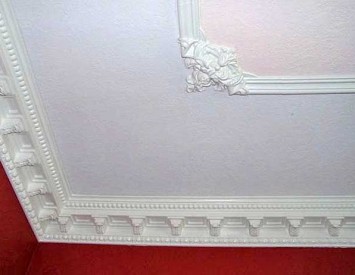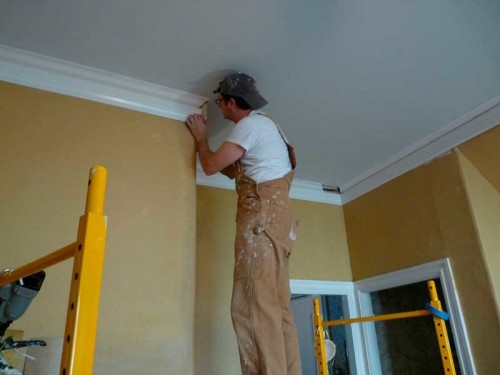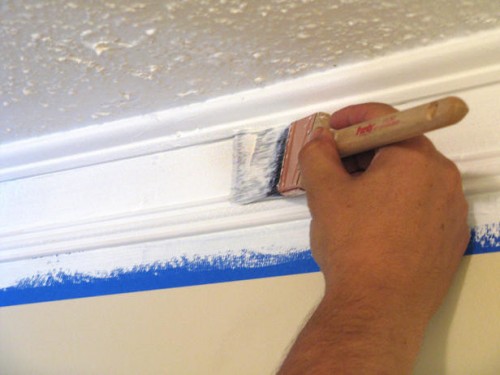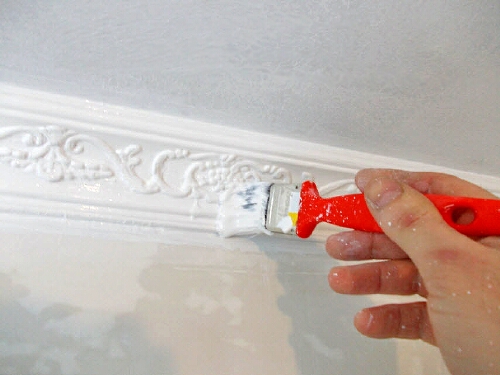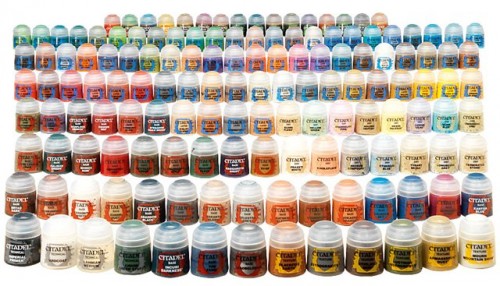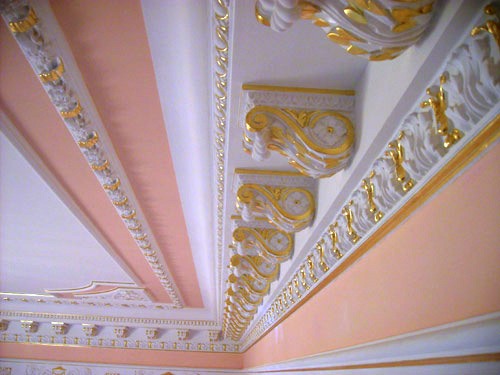When the repair in the apartment approaches its finish line, it is necessary to glue, and then stick and paint the baguette, in other words, a ceiling skirting board. It seems that the operation is simple, but having completed the work not of high quality, you can ruin the whole impression of the repair. How to putty and paint a ceiling baseboard correctly? You will find the answer to this question in this article.
Content
Why put a ceiling skirting board for?
The putty of the ceiling skirting boards is the necessary work, because if you glue it, and leave it, then the view will spoil the gaps formed due to uneven the wall, the places of the joints are highlighted well.
Subtleties of putting the ceiling skirting boards
There are certain requirements for putty itself, and which we consider:
- the putty should fill all the cracks, joints, so we choose small;
- in the case of a very uneven wall, the gaps are especially large to close them, we take the putty based on gypsum, and then use the finish mixture.
Putty process
Before putting it up with a ceiling plinth, we will examine it and start working with the largest cracks, that is, the width of which is exceeding 0.3 cm, and for this: for this:
- we clean the ceiling skirting board from dust;
- we prepare a plaster solution using a putty, the basis of which is gypsum;
- we take a regular spatula and cover the cracks. The remnants of the putty are carefully removed with a wet rag or spatula;
- we give the starting putty to dry, carefully clean the surface of the ceiling skirting board with sandpaper;
- we dilute the finish dry putty so that it is convenient to apply it with a fold brush and complete the work;
- if the baguette is patterned, then the spatula cannot be used, everything is done with a brush, and at the joints the excess is removed with a sponge.
Healthy: Spacing the seams between the fillets, make vertical movements with a spatula, repeating the relief of the ceiling baguette, then it will look like one solid canvas.
Which plaster mixture is better?
If you choose a plaster based on gypsum, then opt for a universal dry plaster mixtan (Rotband), which is produced in Germany, KNAUF (KNAUF). Its advantage:
- it includes additives that provide excellent adhesion, therefore it will not exfoliate from the ceiling skirting board;
- small proportion;
- consumed economically.
To seal small cracks, you can use the finish fine -grained putty Eskaro Fine Filler, supplied from Estonia. She is distinguished:
- high adhesive properties;
- ease of application;
- the presence of packages of different weights.
The finished putty produced by the company "Prospectors" also established itself well. It stands out:
- good technical data;
- environmental safety;
- the fact that includes the quality components of companies from Germany “Bayer” and “Wacker”, the French company Rhodia.
For putty, you can also use glue-spaces for ceiling skirting boards, through which it was attached to the wall. If there is no finished mixture left, then prepare it yourself in this way:
- dilute the finish putty according to the instructions;
- add PVA glue to the solution based on: 1 kg of putty - 0.15 kg of PVA.
Do I need to paint the ceiling plinth
Baget painting is not a mandatory procedure, so the question is: "Do you need to paint a ceiling plinth?" Everyone decides on his own, but if we want to ensure that in the interior of the room after repair there is nothing to complain about, it is better to perform this procedure. And in favor of making a positive decision, the following factors say:
- by painting a ceiling skirting board, you can make it completely in harmony with the overall design of the room;
- the ceiling baseboard, thanks to a successfully selected color scheme, will play the role of a contrasting line separating the walls and ceiling or smooth out the contrast between them;
- the color of the ceiling plinth will strengthen it, since the material from which it is performed is soft and not very durable;
- with the help of paint, the texture and stucco molding on the baguette stand out well;
- since the baguette is made of polystyrene, polystyrene and polyurethane, and these are porous materials, they will simply lose their presentability without painting. The painted ceiling baseboard can be wiped;
- after sealing the cracks with putty, no matter how carefully we do it, there will still be no uniformity of the material. The output is one: coloring. She will hide all the flaws and such a design element as a ceiling baseboard will look monolithic.
We paint a ceiling plinth
Before painting ceiling skirting boards, you need to decide on the choice of paint and stock up on the necessary tool.
Ceiling skirting
When deciding which paint to paint the ceiling plinth, pay attention to the following:
- ceiling skirting boards made of polyurethane and polystyrene are melted with paints, which include aggressive components. Therefore, choose latex, acrylic, water-dispersive paints;
- the tone of paint should be in harmony with the color of the walls and ceiling. The desired color, in the case of using paints with a water base, is obtained by independently by applying the ring.
Selection of a tool for painting a ceiling plinth
We will work:
- brush. When choosing it, we pay attention to the width - it should not be wider than the baguette itself, but very narrow does not fit;
- in the process of painting, you will have to quickly wipe the spray, so a rag or sponge is needed at hand;
- so that only the baguette is painted, and not the sections of the walls and ceiling adjacent to it, buy a protective painting tape or tape;
- since the work will be performed at a height, a ladder will be required.
Two coloring options
They paint ceiling skirting boards in two different ways:
- after the baguette is glued;
- before gluing.
The best option is when the ceiling skirting board is installed in front of the wallpaper, then it is plastered and painted easily, and it is more convenient to paint in the second option, but the installation will become more complicated here. Having painted the fillets on the floor and then installed, the joints will have to be puttled, and then again paint.
The rules that must be followed when painting
Having chosen the first method of painting the ceiling plinth, we adhere to the following rules:
- putty or glue should dry completely;
- if there is dust and pollution, remove;
- if the wallpaper is not yet glued, we begin to immediately paint;
- in the case when the wallpaper is already on the wall, we protect them using the painting tape. You can protect the wall and a wide spatula, applying it close to the baguette and moving as it stains;
- working with a brush, we apply paint to the outer surface of the baguits;
- joints should not stand out after applying the paint layer, and if they still stand out, then it is necessary to repeat the procedure.
Take a note: If there is a decorative stucco molding on the surface of the skirting board, then, when staining it, make a brush with a brush that simulates the vigor, otherwise the excess paint will form, which will begin to drain.
It lies well on the surface of the ceiling skirting booth water -based paint, the Triora brand (trior). Its advantages include:
- water resistance - a surface painted with this paint can be washed;
- vapor permeability;
- lack of unpleasant odor;
- pronounced shine;
- a wide color palette.
It is used for painting ceiling polyurethane skirting boards with stucco moldings and such tinting material as a glaise related to cerebrial colors. With its help, an ordinary baguette can be aged, given the effect of metal, stone, wood and even gold. It goes without saying that a wide ceiling skirting board is suitable for painting by Gles.
We use Glaise
In order to apply a glaise to the ceiling skirting board with stucco molding, you will need:
- a spray can with a glaise or a spray gun;
- brush;
- a sponge or a rag.
The procedure for applying it is as follows:
- we spray the glaze on the surface;
- we take a brush, sponge or rag and rub out to obtain a tinted effect.
We patin the ceiling skirting board
In order for a simple ceiling baguette to look like an antique thing, it needs to be patrol with a glaise. It is not difficult to do it:
- we buy glaises with Tair and Umber colors;
- we apply a glaise of Tair's color in an even layer on the upper and lower part of the ceiling skirting board, leaving not a painted middle;
- now with a sponge it is necessary to execute a bubble at the junction site of a painted area with unpainted. At the same time, we remove the outer layer of paint. At the same time, the convex relief will become lighter and brighter, and the recesses will contrast with the color of reliefs;
- to emphasize the relief, we use Umber Glaase.
Here is a clear example of creating an antique effect on a ceiling plinth: 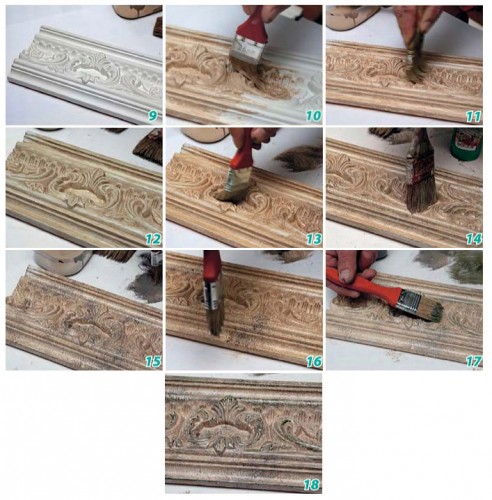
We create a stone effect
If our skirting board has a large highlighting pattern, then it can be given the effect of natural stone, slightly dirty, surface:
- glaze TAIRE apply a thick and uniform layer to the surface of the baseboard;
- we shade the surface with a brush so that light strokes form;
- using Glazer Umbert, we cover the surface with dark spots;
- we shade;
- we apply small strokes of dark color, remove excess;
- let the surfaces dry;
- we put strokes to the reliefs using a bronze glaze;
- leave for drying.
In the room, the design of which is made in the Baroque style, a ceiling skirting board with gilding will be appropriate.
Gilded skirting
For work, you will need:
- glaze gold or silver color;
- the brush is thin;
- rag.
Technology:
- dipping the brush into the Glaze;
- we take a rag and remove the paint from the brush;
- we put the brush on the protruding part of the pattern and slowly move it horizontally. In this case, the paint will remain only on the bulges.
The process of preparing for painting and the most painting can be found using these videos:
